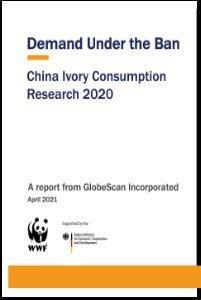Demand Under the Ban: China Ivory Consumption Research 2020
By Wander Meijer, Dr. Daniel Bergin, Timothy Cheng, Crystal Yang, and Dr. Eugene Kritski .
The large-scale consumption of wildlife parts, products, and derivatives across the globe is increasingly being recognized as a driving factor toward substantial declines in populations for many species. Mainland China (hereafter referred to as ‘China’ in this report) is thought to be one of the largest markets, leading conservation professionals to explore the potential for targeted advocacy, social marketing, and multi-media campaigns to deliver real and rapid impact in reducing this demand. WWF have implemented several behavior change interventions in recent years to reduce demand for illegal wildlife products like ivory, pangolin scales, rhino horn, and tiger bones. Consumers including outbound tourists, persistent buyers, collectors, businessmen, and traditional medicine users have been targeted in those behavior change interventions. Within this context, a “game-changing” ban on commercial processing and trade in elephant ivory was implemented by the State Council, China’s Cabinet on 31 December 2017. TRAFFIC and WWF commissioned GlobeScan before the ban became effective in 2017 to conduct the largest-ever ivory consumer research in China. This research seeks to discover the nature of ivory consumption in 15 major cities in China, to understand consumers’ perception toward the ivory ban, and to assess effective messaging and mechanisms for demand reduction based on a pre- and a post-ban surveys, conducted in September – October 2017 (pre-ban), May – June 2018 (post-ban), May – July 2019 (post-ban) and October 2020 - January 2021 (postban). The research will also serve as the foundation of WWF’s future behavior change strategies and interventions.
Beijing, China: World Wildlife Fund, 2021. 119p.


